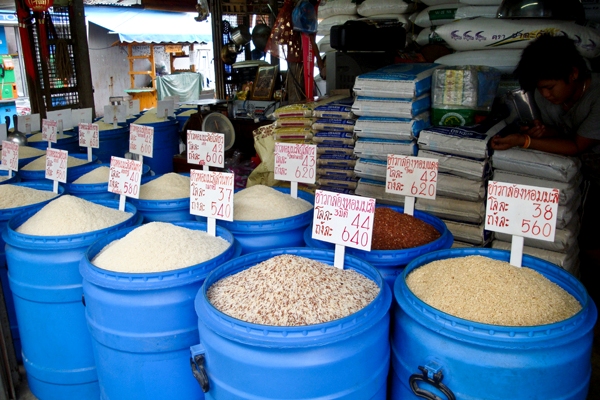
The global rice market has been quite uneventful in the past several months. The news of possible monsoon failure in India and Southeast Asia because of El Niño, the uncertainties involving the Thai rice-pledging scheme, and the fate of existing rice stocks have failed to perturb the market.
 The only exceptional event in the market has been the steady downward slide of Thai rice prices because of uncertainties in the pledging scheme. Between February 2013 and May 2014, the Thai price for 25% broken rice declined by more than 40% from US$584 to $346 per ton (Fig. 1). During the same period, the large spread of $150–200 per ton between Thai and competitor prices (India, Vietnam, and Pakistan) more or less disappeared, and, in some cases, the Thai price fell below some competitor prices.
The only exceptional event in the market has been the steady downward slide of Thai rice prices because of uncertainties in the pledging scheme. Between February 2013 and May 2014, the Thai price for 25% broken rice declined by more than 40% from US$584 to $346 per ton (Fig. 1). During the same period, the large spread of $150–200 per ton between Thai and competitor prices (India, Vietnam, and Pakistan) more or less disappeared, and, in some cases, the Thai price fell below some competitor prices.
This has enabled Thailand to export more in the international market. During the first four months of 2014, Thai rice exports increased to 2.93 million tons compared with 1.98 million tons during the same time a year ago.
The failure of the Thai government to raise funds for the pledging scheme to continue because of political turmoil and the caretaker status of the government led to the steep decline in Thai rice prices in the past several months. In addition, the government has been auctioning rice from existing stocks to raise funds to pay off farmers who pledged rice late last year, putting further downward pressure on Thai prices.
Although the current military junta in Thailand is concerned about the low rice prices for farmers, it is not clear what measures it will implement to raise these prices. The government has also not spelled out its plan on how its existing stocks will be released to the market. We hope that the current government will not repeat the mistake made by its predecessor and will find a nondistorting way to support farm income if it desires to do so and let the market work. If this happens, Thai rice exports will rise and, undoubtedly, the country will become the top exporter again.
Apart from political uncertainties in Thailand, the rice market also faces weather uncertainties in the coming months because of El Niño. Many rice-growing countries in South and Southeast Asia are cautiously optimistic on rainfall distribution in the next few months that will determine the fate of the biggest crop of the year.
In the case of India, the largest rice exporter in the world, where the wet season crop accounts for more than 85% of the total crop, the southwest monsoon arrived in Kerala on 6 June, after missing its date with the country by 5 days. Some uncertainties exist on how quickly it will spread to the rest of the country. Earlier this season, forecasters had predicted the monsoon rainfall in India this year to be 95% of the long-term average, with an error of ±5%. Apart from India, two Southeast Asian rice importers, Indonesia and the Philippines, are also bracing for weather disruptions from El Niño.
Where is the market going?

This all depends on the fury of El Niño. If the drought is severe in large parts of South and Southeast Asia, it will put pressure on rice prices despite adequate global rice stocks right now. We are undoubtedly in a much better position with a global stocks-to-use ratio of 23.5% now compared with 18.5% in 2007 (Fig. 2). The stocks have increased by 36 million tons from 75 million tons in 2007 to 111 million tons in 2014.

But the bad news is that almost all the increases in these rice stocks (Fig. 3) are primarily with India, China, and Thailand—and a majority of them are in government warehouses rather than with private traders. In case of a crisis or production shortfalls, this may create panic among rice-importing countries as they will be unsure whether these government-held stocks will be available for sale and at what price.
In the case of India, the new government was just sworn in a few weeks ago and it is not clear how it will react to any significant production shortfall caused by weather disruptions. As of 16 June 2014, the monsoon season was already 10 days behind in a majority of the rice-growing belts in the country. The new government is already jittery about the poor prospects of monsoon crops, particularly rice. Although the current government rice stock of 28 million tons (as of 1 June 2014) is at a quite adequate level, it has declined by 4 million tons from 32 million tons at the same time last year. The new government will be under pressure if planting is substantially delayed because of the late onset of monsoon and it may take measures to restrict exports, at least for nonbasmati rice, to safeguard its domestic food supply and keep enough in its warehouses to meet the need of the National Food Security Act (see India makes access to food a right, not a privilege).
In the case of Thailand, it is becoming more evident that its rice-pledging scheme will not come back. Without it, it is a no-brainer that Thai farmers will plant less rice in the wet season. But, that should not be a problem for the global market because Thailand has plenty of stocks to make up for the shortfall.
Indonesia and the Philippines, two major rice importers in Southeast Asia, are also expected to be affected by El Niño. As of April 2014, the Philippines had a rice stock of 2.18 million tons, sufficient for 64 days of domestic consumption. Similarly, Indonesia has 6.8 million tons of rice stock to meet its domestic consumption for 62 days. So, any significant weather disruptions will push these countries to import more, thus raising global rice prices. China, the largest importer of rice in the world, is also expected to be affected by El Niño in the form of heavy rains and flooding in the major rice-growing parts of the country. If the rice crop is affected and the domestic rice price goes up, Chinese traders will have more reasons to import more rice than what market pundits have predicted.
Overall, the market is well positioned to handle a moderate drought and other incidences of extreme weather. Thai rice stocks will come in handy to keep the market stable to some extent, but significant weather disruptions in key rice-growing countries will eventually move prices higher. We hope that countries will not repeat the mistakes they made in 2007 by imposing an export ban and stockpiling in anticipation of shortage. Otherwise, we might be heading for another crisis.
_________________________________________
Dr. Mohanty is head of the Social Sciences Division at the International Rice Research Institute.









